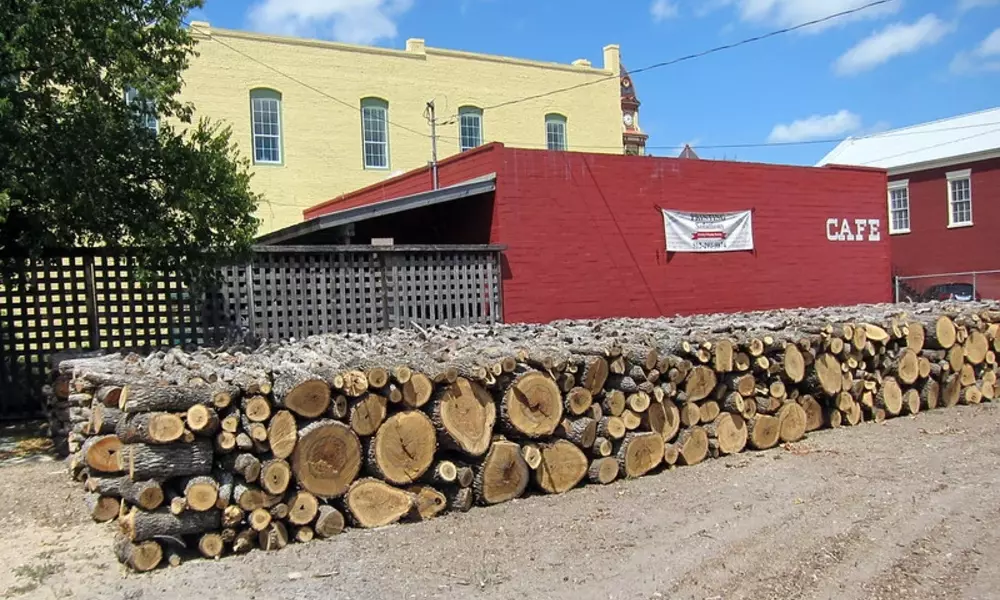If you’re familiar with firewood storage, you may have come across the term “rick of wood.” In this article, we will delve into the details of a rick of wood, addressing common problems associated with firewood storage, and offering promising solutions backed by thorough research.
We will explore the dimensions of a rick, discuss the importance of properly storing firewood, and provide practical tips for efficient firewood stacking. Additionally, we will share our opinion on the benefits of using a rick and address common misconceptions.
This thorough book will therefore give you the information and tools you need to get the most out of your firewood storage experience, whether you’re an experienced firewood lover or you’re just beginning to explore the world of wood-burning.
What is a Rick of Firewood?
A rick of wood refers to a specific measure of stacked firewood. It is commonly used to estimate the quantity of wood being stored or sold.
The term “rick” has its origins in Old English and was used to denote a stack or pile. In the context of firewood, a rick is essentially a compact stack of wood logs.
Dimensions of a Rick of Wood
The dimensions of a rick of wood can vary, but it typically measures approximately 4 feet high, 8 feet long, and 4 feet deep.
It’s crucial to remember that the size can vary depending on the region and the person’s preferences.
These measurements are a general guideline and can be adjusted to accommodate personal needs and space constraints.
The Importance of Properly Storing Firewood
Storing firewood properly is crucial to maintain its quality and ensure optimal burning efficiency. When firewood is exposed to moisture, it can lead to decay, mold growth, and reduced heat output.
By storing firewood in a rick or a similarly structured stack, air circulation is improved, allowing the wood to dry out more effectively and minimizing the risk of deterioration.
Factors to Consider When Storing Firewood
To maximize the lifespan and quality of firewood, there are several factors to consider when storing it:
1. Location
Choose a location for your firewood stack that is well-ventilated and protected from excessive moisture. Avoid placing it directly against a wall or the ground, as this can hinder airflow and lead to moisture retention.
2. Orientation
Stack the firewood in a way that promotes airflow and drainage. Placing the logs in a crisscross pattern or using spacers between the layers can facilitate better drying.
3. Covering
Use a tarp or a waterproof cover to protect the firewood stack from rain and snow. This will prevent moisture from seeping into the wood and ensure that it remains dry and ready for use.
4. Sunlight
While it’s important to protect the firewood from excessive moisture, some exposure to sunlight can aid in the drying process.
Find a balance between providing shade to prevent direct rainfall and allowing sunlight to reach the wood to aid in the drying process.
5. Accessibility
Consider the convenience of accessing the firewood when needed. Place the stack in a location that allows for easy retrieval without obstacles or hazards.
Tips for Stacking Firewood
Properly stacking firewood is crucial for stability, air circulation, and efficient use of space. Here are some tips to help you stack your firewood effectively:
1. Clear the Area
Before stacking the firewood, clear the area of debris, vegetation, and any potential fire hazards. This will ensure a safe and clean space for your woodpile.
2. Start with a Base
Begin by creating a sturdy base for your stack. Use flat and level ground, or you can lay down pallets or a layer of bricks to elevate the wood and promote airflow underneath.
3. Stack in Rows
Place the logs in rows, aligning them neatly to create a stable and organized stack. Consider alternating the direction of the logs with each row to enhance stability.
4. Leave Space for Air Circulation
Allow adequate space between the logs to promote air circulation. This will facilitate the drying process and reduce the chances of mold or decay.
5. Consider Shelter
If possible, build a simple roof or use a tarp to provide additional protection from rain or snow while still allowing airflow.
How to Determine the Amount of Firewood in a Rick
Estimating the amount of firewood in a rick can be useful when purchasing or selling wood. To determine the quantity, you can follow these steps:
- Measure the length, width, and height of the rick in feet.
- Multiply these measurements to calculate the total volume in cubic feet.
- Convert the cubic feet to cords, which is the standard measurement for firewood. One cord is equal to 128 cubic feet.
- Divide the total volume by 128 to obtain the number of cords in the rick.

The Benefits of Using a Rick of Wood
Using a rick of wood for firewood storage offers several advantages:
- Efficient use of space: The compact dimensions of a rick allow for optimal storage capacity while minimizing the footprint.
- Improved drying: Stacking firewood in a rick promotes better airflow, leading to faster and more efficient drying of the wood.
- Easy measurement: Estimating the quantity of wood becomes simpler when using a standardized unit like a rick.
Common Misconceptions about Rick of Wood
There are a few misconceptions surrounding the term “rick of wood.” Let’s address them:
1. Rick versus Cord
A rick and a cord are not the same. A cord is a larger unit of measurement, equivalent to 128 cubic feet, while a rick is a smaller, more localized unit with varying dimensions.
2. Universal Dimensions
The dimensions of a rick of wood can vary depending on location, supplier, or personal preference. It’s important to clarify the dimensions when purchasing firewood to ensure accuracy.
Seasoning and Drying Firewood
Seasoning firewood is the process of drying it to reduce moisture content for efficient burning. Properly seasoned firewood has several benefits:
- Heating value: Seasoned firewood burns more efficiently, producing more heat and less smoke compared to green or unseasoned wood.
- Reduced creosote buildup: Properly dried firewood helps prevent the accumulation of creosote in the chimney, reducing the risk of chimney fires.
- Longer burn time: Seasoned firewood burns longer and provides a sustained heat source, making it ideal for heating purposes.
To season firewood effectively, follow these steps:
- Split the wood: Splitting the logs into smaller pieces exposes more surface area, allowing for quicker drying.
- Store the wood in a dry, well-ventilated area: Stack the split firewood in a rick or similar structure, ensuring proper airflow to facilitate drying. Avoid stacking the wood directly on the ground to prevent moisture absorption.
- Allow sufficient time: Depending on the type of wood and environmental conditions, firewood generally requires six months to a year to season properly. During this time, the wood should be protected from rain and snow but exposed to natural airflow.
- Check for moisture content: To ensure the firewood is adequately seasoned, use a moisture meter to measure the moisture content. Ideally, the moisture content should be below 20% for optimal burning.
Different Types of Wood for Burning
Not all wood is created equal when it comes to burning. Different types of wood have varying heat outputs, burn rates, and characteristics.
Here are a few common types of firewood:
- Hardwoods: Hardwoods such as oak, maple, ash, and birch are dense and provide longer burn times and more heat output. They are ideal for heating purposes.
- Softwoods: Softwoods like pine, spruce, and fir ignite quickly and produce a lively flame. They are suitable for starting fires but burn relatively faster.
- Fruitwoods: Fruitwoods like apples, cherries, and pears offer a pleasant aroma and produce a steady heat output. They are often used for smoking and cooking purposes.
When selecting firewood, consider the specific characteristics you desire, such as heat output, burn time, and aroma.
Maintenance and Safety Tips
To ensure a safe and efficient firewood storage and burning experience, follow these maintenance and safety tips:
- Regularly inspect the firewood stack for signs of decay, mold, or pest infestations. Remove any compromised logs promptly.
- Keep the area around the firewood stack clean and free of debris to minimize fire hazards.
- Store flammable materials at a safe distance from the firewood stack.
- Practice proper fire safety measures, including using a screen or spark arrestor when burning firewood in a fireplace or wood stove.
- Clean and inspect chimneys regularly to prevent creosote buildup.
- Use appropriate safety equipment, such as gloves and goggles, when handling firewood.
Conclusion
A rick of wood refers to a stack of firewood with specific dimensions commonly used to estimate the quantity of wood. Storing firewood in a rick allows for efficient drying, proper air circulation, and convenient measurement.
By following proper stacking techniques, seasoning firewood, and considering the type of wood for burning, you can ensure a reliable and cozy source of heat.
Remember to prioritize safety and maintenance to enjoy the benefits of a well-stocked and well-maintained firewood supply.
 What To Plant In Front of Boxwoods |
 How to Get Rid of Ground Moles with Vinegar |
FAQs
Q1. How much wood is a rick?
A rick of wood typically holds around 1/3 to 1/2 of a cord of firewood.
Q2. How many ricks are in a cord of wood?
There are typically 2 ricks in a cord of wood.
Q3. How many ricks of wood fit in a pickup truck?
The number of pieces of wood that can fit in a pickup truck depends on the size of the truck bed and how the wood is stacked. On average, a pickup truck can typically accommodate 1 to 2 ricks of wood.
Q4. What does a rick of wood sell for?
The price of a rick of wood can vary depending on factors such as location, type of wood, and market conditions. On average, a rick of wood can range in price from $100 to $300.
